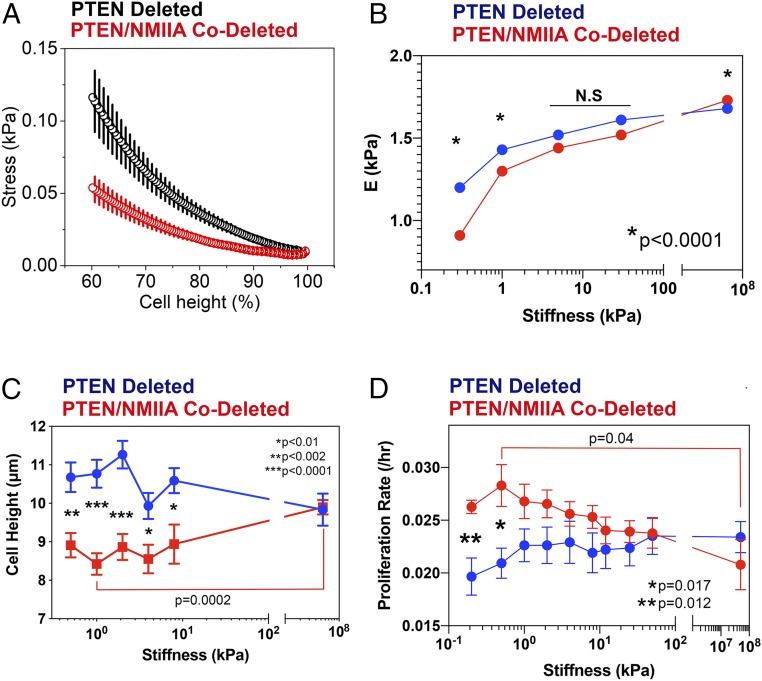Fig. 4.
NMIIA deletion alters GBM cell mechanics in a manner influenced by the stiffness of the tumor environment. (A) Global cell deformation was performed using a JPK Nanowizard 4 atomic force microscope equipped with cantilevers of a nominal stiffness of 2.4 N/m with a 25-µm-diameter sphere attached (Novascan). Measurements of cell deformability were made on PTEN-deleted (black) and PTEN/NMIIA-codeleted cells (red) grown on glass coverslips coated with collagen I. Force versus distance curves were converted into stress versus percentage of unstressed cell height curves with the assumption that normal stress can be calculated as the ratio of the applied force to the area of deformation. The percent cell height was calculated as the percentage of the total cell height that underwent indentation at a given force. (B) The local Young’s modulus was calculated from local cell cortex deformation measurements on PTEN-deleted (blue) and PTEN/NMIIA-codeleted (red) murine GBM cells, cultured on a range of substrate stiffness. Data are plotted as mean ± SEM. This reveals that NMIIA deletion reduces Young’s modulus compared with NMIIA-intact cells on soft surfaces and increases it on hard surfaces. Statistical significance was determined with a two-tailed t test. (C) Cell height was measured on NMIIA-intact (blue) and -deleted (red) tumor cells cultured on fibronectin-coated hydrogels (Softwell; Matrigen) covering a range of stiffness from 0.2 kPa to plastic. NMIIA-deleted cells are shorter than NMIIA-intact ones, and this difference decreases with increasing stiffness. Cell height for NMIIA-deleted cells on plastic is also significantly increased compared with the same cells grown on a 1-kPa surface. Statistical significance was determined with a two-tailed t test. (D) Plot of proliferation rate constant versus substrate stiffness for PTEN-deleted (blue) and PTEN/NMIIA-codeleted (red) tumor cells grown on fibronectin-coated Softwells (Matrigen). Growth kinetics were fit to a single exponential growth equation to yield rate constants, and each point represents the mean ± SEM of five replicates. Differences in rate constants between PTEN-deleted and PTEN/NMIIA-codeleted were significant on substrates of 0.2 and 0.5 kPa (***P = 0.012; **P = 0.017) using a two-tailed t test. Furthermore, the difference in rate constant for PTEN/NMIIA-codeleted cells grown on 0.5 kPa and on plastic is also significant (*P = 0.04).

